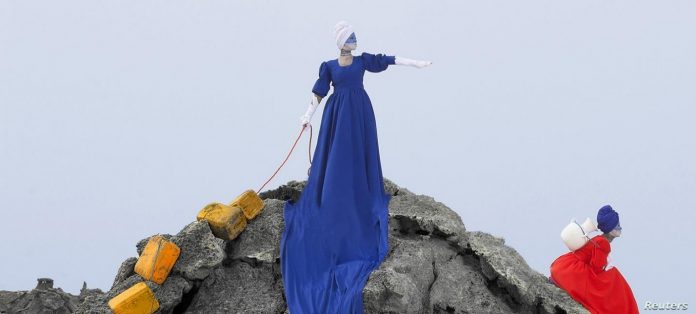By Thomson Reuters
In Ethiopia, almost four in 10 people do not have access to clean water and a child dies every hour of diseases caused by the shortages
A collection of striking photographs set in the arid landscapes of northern Ethiopia aims to spotlight the harsh reality of water scarcity and how it impacts the lives of women across Africa, said artist Aida Muluneh.
Muluneh’s “Water Life” series – depicting turbaned, painted women in robes of primary colors of blue, yellow and red, posing in the desert – went on show in London on Tuesday, commissioned by the charity WaterAid.
“When WaterAid approached me, I felt that this was something I needed to engage in because water is a big issue in my country, and also the regions that I work in,” Muluneh, an Ethiopian national, told the Thomson Reuters Foundation.
“My work has always focused on the important role of women in society and I have had many conversations with women about the hardships they endure – and access to clean water is one of the biggest challenges they face.”
Globally, one in 10 people do not have access to clean water, according to WaterAid. In Ethiopia, the figure is almost four in 10 and a child dies every hour of diseases caused by the shortages.
As well as harming people’s health, Muluneh said, the shortages have a devastating impact on the lives of women and girls who have to trek long distances to fetch water, making them vulnerable to sexual violence.
Some have to miss school during their periods due to a lack of running water, she said.
Muluneh describes her style as “Afrofuturistic” – a movement that seeks to challenge stereotypical views of the continent and its people – in this case by portraying traditional African ornamentation and body paint in a more futuristic manner. “Through art and creativity, we can also advocate by working on projects such as ‘Water Life’ which address societal issues, but do not perpetuate negative stereotypes of the continent,” she said.
“We’re bombarded with images of suffering and strife from Africa. So for me, it was just about using a different way to engage an audience in issue of water scarcity and the strength of the women that deal with this issue daily.”
Muluneh said working on the project, which involved four days of shooting in Afar’s Dallol region – one of the hottest and driest places on earth – had been an exhausting, yet rewarding experience. Read more>>



